Bow care and maintenance
- Home
- Violin Viola Cello DoubleBass Articles
- Bow care and maintenance
How to look after your bow
Bows are surprisingly fragile. If you look at a violin bow, there is only about 5mm of wood attaching the head to the stick. Therefore it is not advisable to use it for sword fighting or applauding by tapping it on a music stand.
When handling your bow, try not to touch the horsehair with your fingers. If the oil on your fingers is left on the horsehair, the oil will oxidise and the hair will look black. Where oil has accumulated, the hair will fail to take rosin and will not function. Strictly speaking, it is also a good idea to avoid touching the strings between the fingerboard and the bridge to avoid oil from your hands contacting the hair indirectly. Blackening of the hair from oil is often seen near the frog as it can be difficult to avoid the thumb touching this part of the hair. The hair can be cleaned gently with methylated spirits and a clean cloth. This needs to be done carefully as the alcohol can damage the varnish on the stick. Apply more rosin once the hair has dried again.
After playing, use a dry cloth such as a microfibre cloth to clean the stick. Don’t put cleaners or wood polish on the wood. Use just enough rosin to allow a good grip with the strings. Too much rosin will clog the hair and collect on it and the bow can skate instead of gripping.
When a hair breaks, you need to pull it in the opposite direction and break it once it is parallel with the bow. This is easier if you twist that hair around your fingers. Some recommend keeping a small pair of scissors in the case to instead trim the broken hair. If the hair is pulled when positioned 0-90 degrees to the stick, the entire knot of hair can be pulled out of the mortise.
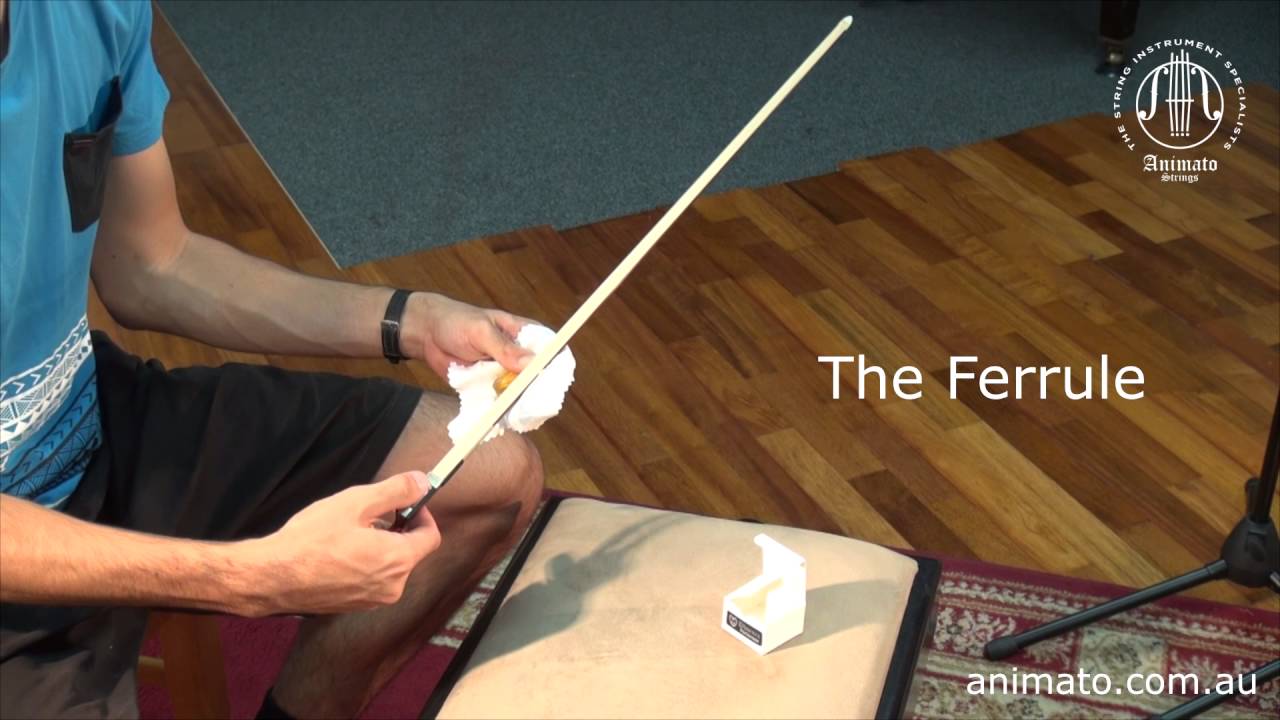
When a hair breaks, you need to pull it in the opposite direction and break it once it is parallel with the bow. This is easier if you twist that hair around your fingers. Some recommend keeping a small pair of scissors in the case to instead trim the broken hair. If the hair is pulled when positioned 0-90 degrees to the stick, the entire knot of hair can be pulled out of the mortise.

Mechanics of the frog
The end button turns a long steel screw inside the end of the stick. There is a brass eyelet screwed into the frog. This eyelet is positioned around the long screw so that as the end button is twisted the frog moves along the screw. This movement of the frog adjusts the tension of the hair. They eyelet is made of a softer metal than the screw and as such the eyelet will wear out before the screw. This is intentional as it is simpler to replace the eyelet than the screw.
If the frog feels loose or is wiggling, the eyelet inside the frog may not be in the right position or the thread in the eyelet has worn. If the screw feels tight or it is not running smoothly, these are other clues that point to a worn eyelet. Once the thread of the eyelet has worn, the bow will not be usable and it is time to replace the eyelet. There are several sizes of eyelet as the thread of the eyelet must match that of the screw. These problems with the mechanics should be checked by a professional.
The head of the bow
The tip or the faceplate of the bow protects the wood underneath from damage. It also provides strength to this area. If the very tip of the faceplate breaks, the wood that is exposed will become worn and this will reduce the value of the bow.
The faceplate (tip) of the bow is not just an ornament; it protects the wood from damage. If the very tip of the faceplate breaks off, the exposed wood will wear, devaluing the bow. If a crack forms from the side of the mortise, the tip may not withstand the pressure of the plug. This should be attended to.
Putting the bow away
When you put your bow away after playing, make sure that you loosen the hair by twisting the end button to the left. The hair will then need to be tightened by twisting the end button to the right before playing. When the hair is not relaxed, it can stretch and the constant tension on the stick will result in it losing its curve or camber. The camber of the bow provides its spring. As you wind the button, hold the bow firmly with your thumb over the pearl slide. Holding the bow like this keeps the frog and the stick in proper alignment with each other and reduces wear to the eyelet and screw. The recommended distance between the horsehair and the stick for playing is the same as the diameter of the stick.
Bow bugs
AKA dust mites or carpet beetles, these are tiny dermestid insects and disliked immensely by string players. Unfortunately there is a higher density of dust mites in Australia which is evident from our higher rates of asthma. The larvae of bow bugs like to feed on horsehair. They have also been known to eat natural gut, tortoiseshell and the glue that holds string instruments together! They don’t like fresh air and sunlight so a bow that is played regularly will be unlikely to suffer from the broken hairs caused by their feeding habits. Evidence of their work is most often seen in old cases that have stored instruments that have not been played for long periods of time.
Preventing dust mites in a violin case can involve vacuuming the inside thoroughly and spraying with a permethrin based insecticide. Remove everything prior to doing this and allow the case to dry before returning the instrument and bow to the case. You can also sit the case in sunlight after vacuuming. Cedar oil can be used to repel dust mites. Apply a small amount to the case lining near where the scroll will sit and a small amount near the chin rest. If you are going away on holidays, you can store your bow in a safe airy place out of direct sunlight. This can be safer than storing it in the case.
When an old case is showing evidence of dust mite infestation, consider purchasing a new case as this will provide better care for your instrument and case.
Rehairing the bow
The hairs on a bow should be parallel with no hairs crossed. The tension should be even across the width of the ribbon of hair. Uneven tension can result in the stick warping to the side with the greatest tension.
There are several reasons for rehairing:
If a number of hairs have broken on one side of the ribbon as this will also create uneven tension when the bow is at playing tension. You can periodically check for warping of the bow as this is a strong indication for rehairing.
Rehairing is also needed when a reduction of the width of the hair at the ferrule can be seen. The ferrule is the metal ring that surrounds the frog where the hair leaves the bow.
Horsehair has a microscopic structure that allows it it hold an even coat of rosin. This microscopic structure will degrade after being used for a long time. When you notice that more and more rosin needs to be used, this indicates that the hair has worn out and has lost its grip.
The hair can stretch from the tension caused by not loosening it but also from high humidity. Continuing to tighten stretched horsehair can result in the end of the mortise cracking.
A bow is generally considered to be worth re-hairing if it is worth more than the cost of rehairing. Therefore it can be more economical to purchase a new bow rather than rehairing one. The required frequency of rehairing depends on how much the bow is played. Professionals may need to rehair their bow twice a year, a student or casual player less frequently. When a bow is rehaired, the bow maker will consider the humidity of the climate when judging what length to cut the hair. A dry atmosphere causes the hair to shrink and become brittle. If you live in a dry climate, using a humidifier (such as a Dampit) in your instrument will protect the bow while it is in the case.Humidity causes the hair to stretch and it can also cause the stick to warp.
Thumb leather and winding.
The thumb leather is not just on the bow to make playing more comfortable. It also protects the stick from your fingers, thumb and thumbnail. The winding provides protection to the stick. The winding and grip are also an integral part of the balance and weight of a bow- an absent grip will impact on the feel and balance.
The thumb leather and the winding need to be replaced once it has worn through to the stick. If the winding needs to be replaced the thumb leather will also need to be done. The thumb leather can be done independently of the winding.
Humidity
In humid climates, like that of parts of Australia and especially far north Queensland, it is a consistently ignored problem for all parts of the instrument, from the bow to the rosin. In the case of the bow, humidity can both warp the bow in extreme cases and, much more commonly, affect the hair. The hair can be affected by excessive or absent humidity, so it should be something that each player should be aware of. An excess will dampen the hair and make the action of the bow sluggish, commonly accompanied by the need to tighten the bow during play. A very dry climate will dry the hair to the point of the it fraying and breaking. If you live in a dry climate, using a humidifier (such as a Dampit) in your instrument will protect the bow while it is in the case.
Over time the habits needed to look after your bow will become second nature. Once damaged a bow may need to be reincarnated as an expensive garden stake! If you look after your bow carefully, it may last for hundreds of years and contribute to the pleasure that music brings.
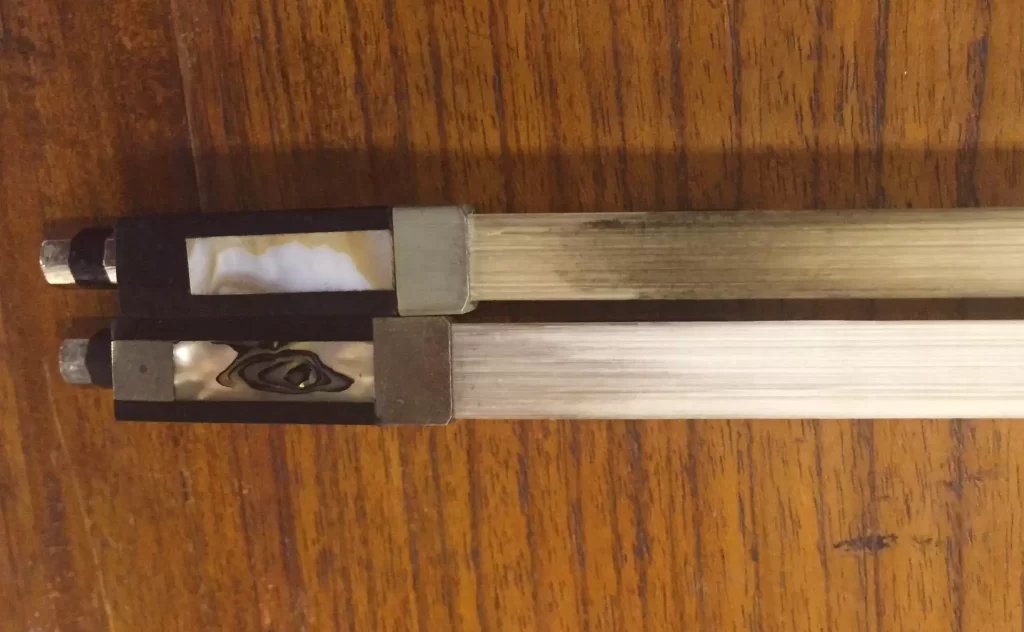
Bow hair showing black oxidation (top) versus new bow hair (bottom)
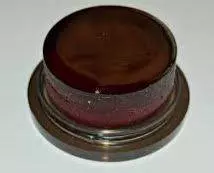
Rosin
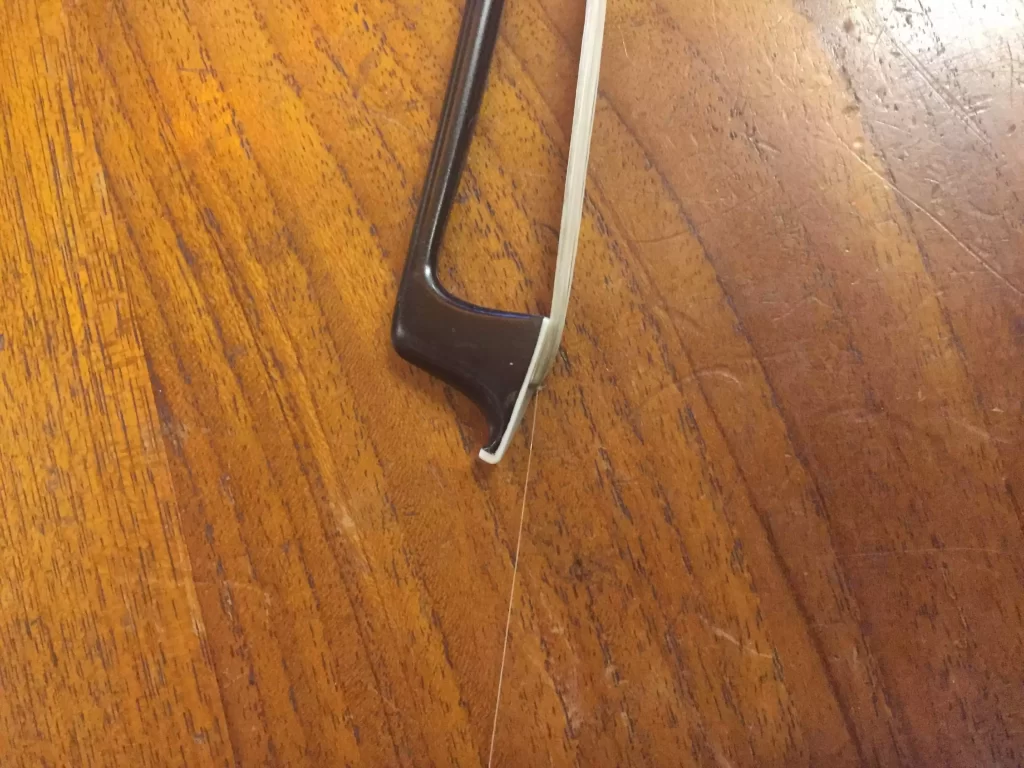
Broken bow hair position before removal

This is a cracked tip (or faceplate) and should be replaced immediately as it results in reduced strength in the tip and will lead to other problems
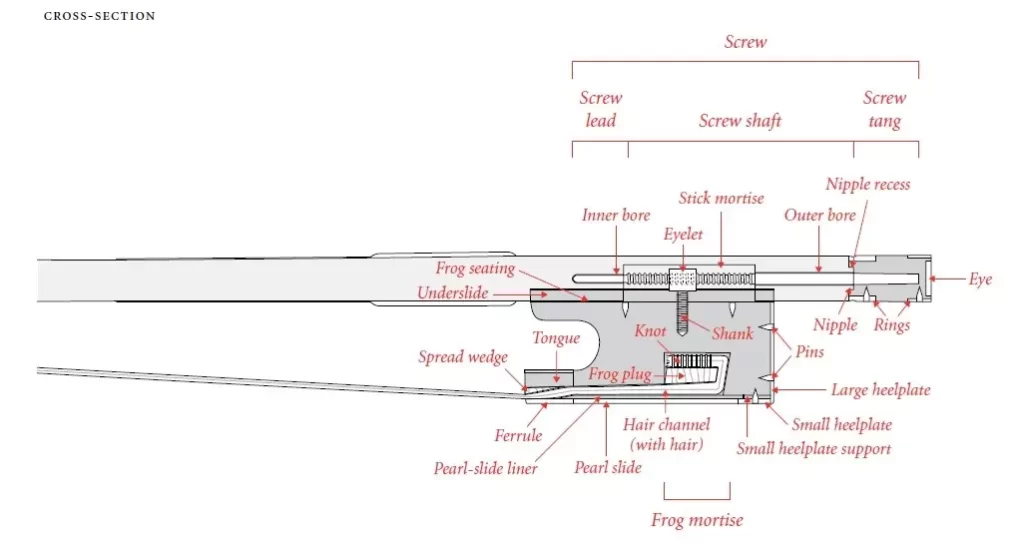
Internal mechanics of the bow frog

An archetier, David Finck, rehairing his bow.

Bow hold to use while twisting the end button

An example of bow bug damage to the hair, and the culprit himself.

An example of bow bug damage
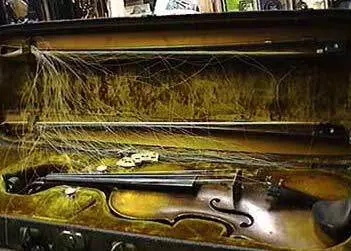
An old case with a bad case of bowbugs
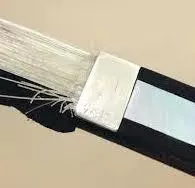
An uneven loss of hair that can cause the bow to warp
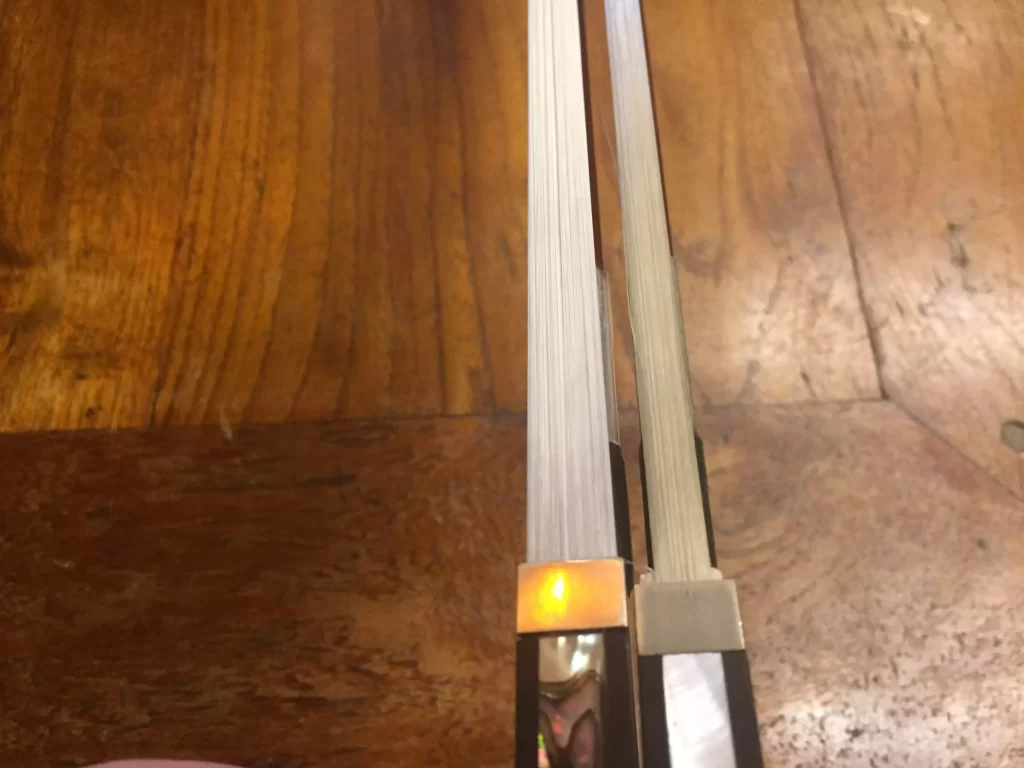
Right-A bow that needs rehairing. Note the narrow ribbon of hair compared to the new bow on lef

